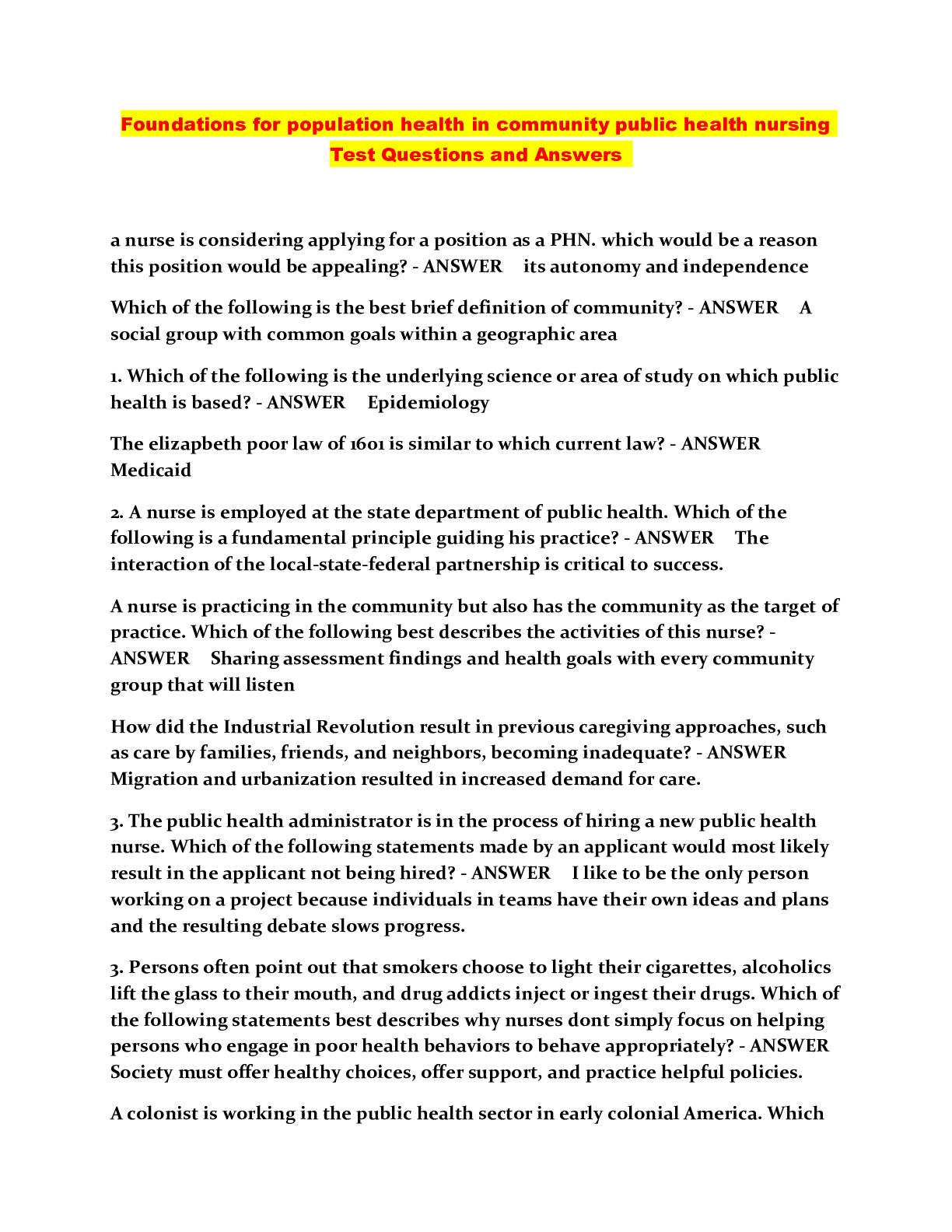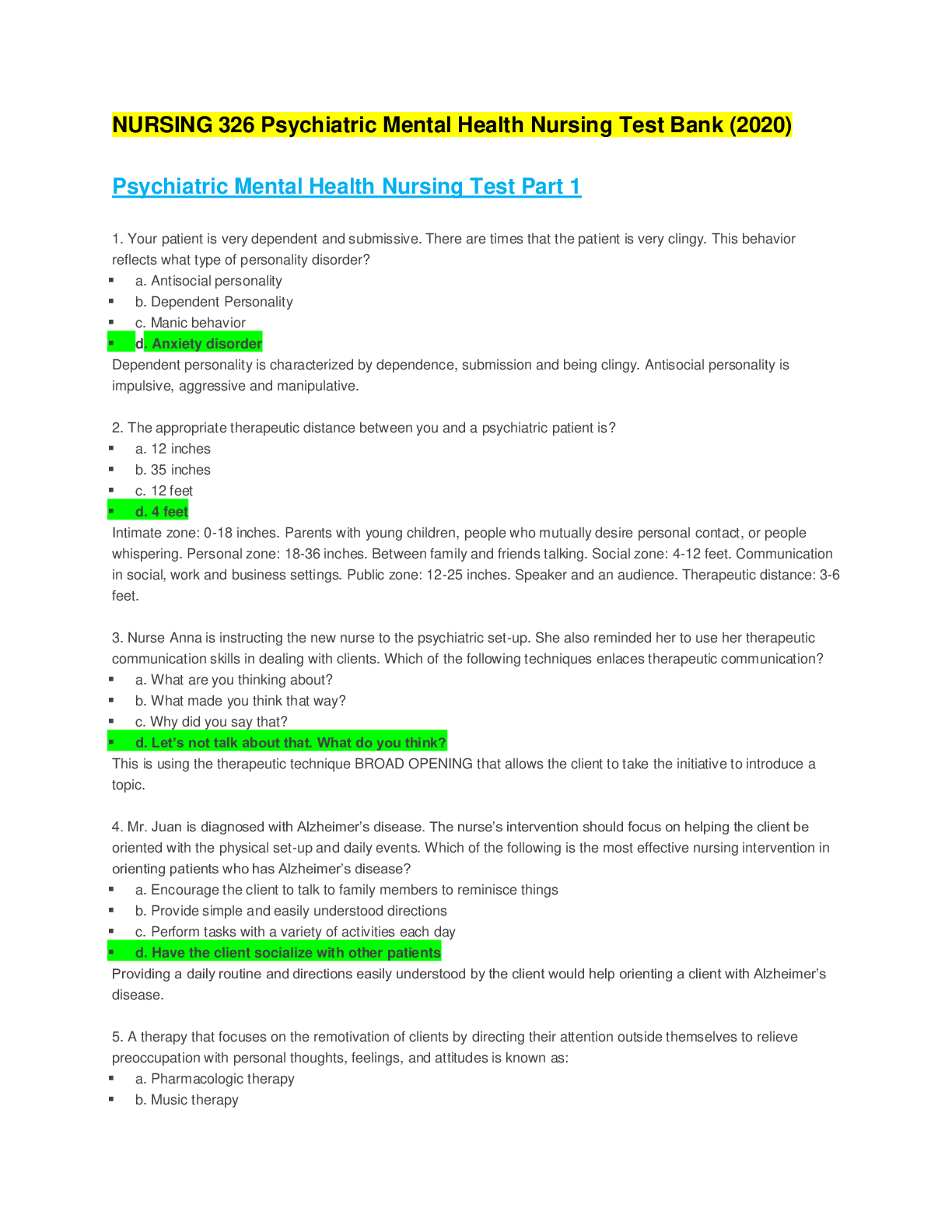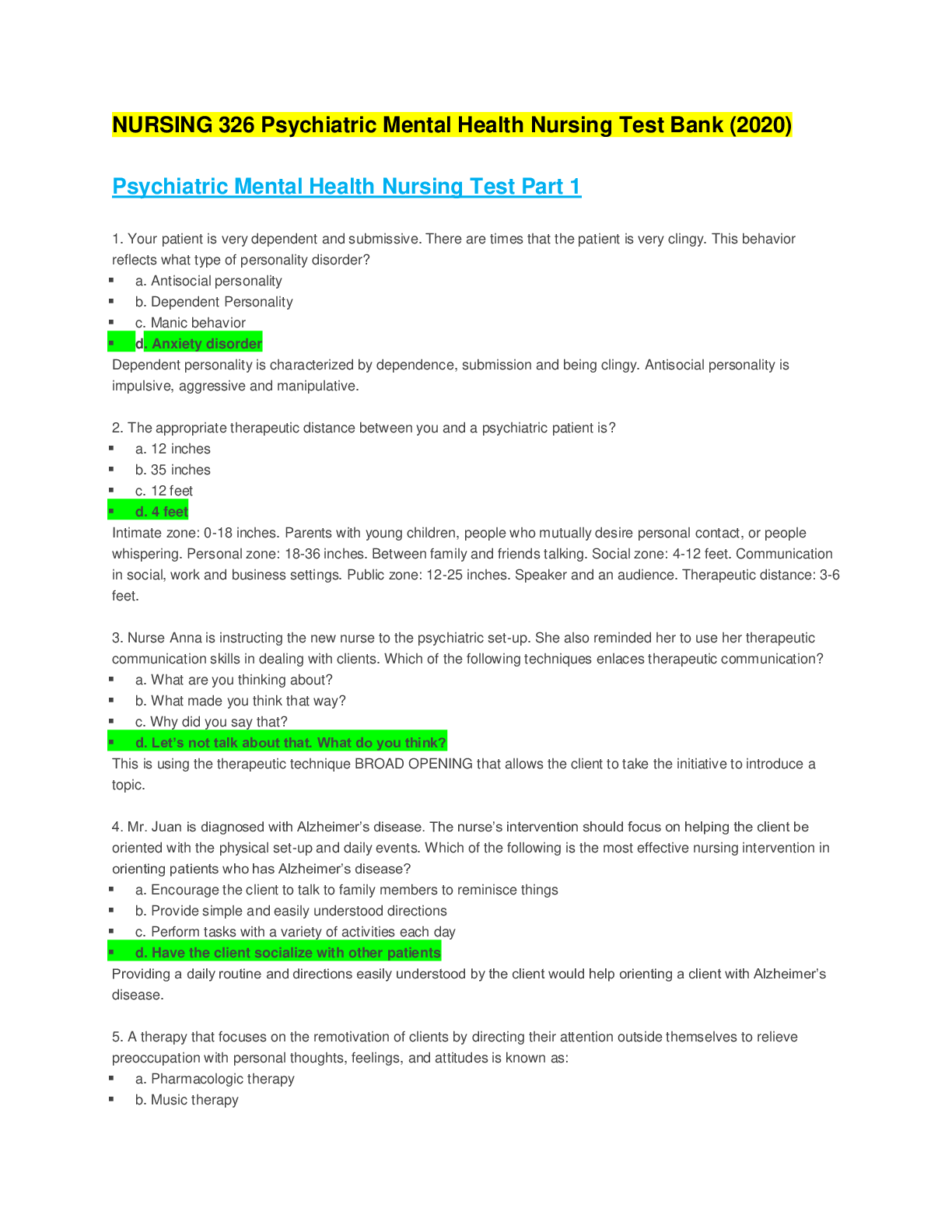*NURSING > QUESTIONS & ANSWERS > NURSING 326 - Psychiatric Mental Health Nursing Test Part 1, Complete Solutions - Chamberlain Colleg (All)
NURSING 326 - Psychiatric Mental Health Nursing Test Part 1, Complete Solutions - Chamberlain College Nursing.
Document Content and Description Below
NURSING 326 - Psychiatric Mental Health Nursing Test Part 1 1. Your patient is very dependent and submissive. There are times that the patient is very clingy. This behavior reflects what type of ... personality disorder? a. Antisocial personality b. Dependent Personality c. Manic behavior d. Anxiety disorder Dependent personality is characterized by dependence, submission and being clingy. Antisocial personality is impulsive, aggressive and manipulative. 2. The appropriate therapeutic distance between you and a psychiatric patient is? a. 12 inches b. 35 inches c. 12 feet d. 4 feet Intimate zone: 0-18 inches. Parents with young children, people who mutually desire personal contact, or people whispering. Personal zone: 18-36 inches. Between family and friends talking. Social zone: 4-12 feet. Communication in social, work and business settings. Public zone: 12-25 inches. Speaker and an audience. Therapeutic distance: 3-6 feet. 3. Nurse Anna is instructing the new nurse to the psychiatric set-up. She also reminded her to use her therapeutic communication skills in dealing with clients. Which of the following techniques enlaces therapeutic communication? a. What are you thinking about? b. What made you think that way? c. Why did you say that? d. Let’s not talk about that. What do you think? This is using the therapeutic technique BROAD OPENING that allows the client to take the initiative to introduce a topic. 4. Mr. Juan is diagnosed with Alzheimer’s disease. The nurse’s intervention should focus on helping the client be oriented with the physical set-up and daily events. Which of the following is the most effective nursing intervention in orienting patients who has Alzheimer’s disease? a. Encourage the client to talk to family members to reminisce things b. Provide simple and easily understood directions c. Perform tasks with a variety of activities each day d. Have the client socialize with other patients Providing a daily routine and directions easily understood by the client would help orienting a client with Alzheimer’s disease. 5. A therapy that focuses on the remotivation of clients by directing their attention outside themselves to relieve preoccupation with personal thoughts, feelings, and attitudes is known as: a. Pharmacologic therapy b. Music therapy c. Occupational therapy d. Recreational therapy Recreational therapy- Focuses on remotivation of clients by directing their attention outside themselves to relieve preoccupation with personal thoughts, feelings, and attitudes. Clients learn to cope with stress through activity. Activities are planned to meet specific needs and encourage the development of leisure-time activities or hobbies. Recreational therapy is especially useful with those people who have difficulty relating to others (e.g., the regressed, withdrawn, or immobilized person). Examples of recreational activities include group bowling, picnics, sing-along, and bingo. 6. The 12-year old male patient looks like the nurse’s younger brother who is missing for years. During assessment and in the implementation of nursing care the nurse prioritizes this client. One day, when she found the boy crying in his room she hugged him and cried with him. This is an example of: a. Counter-transference b. Transference c. Resistance d. Denial When the nurse displays affection or emotion toward the client counter-transference is occurring. Transference is observed when the patient is displaying emotions towards the nurse. 7. A schizophrenic client is under your care. In reinforcing the functional behavior of this client what will the nurse do? a. Enumerate the symptoms of schizophrenia to the client b. Correct delusional thoughts to orient to reality c. Compliment the client for cessation of acting out behaviors d. Encourage the client to drink his medications religiously According to B.F. Skinner’s behavior medication technique, a client should be praise for good behaviors to help him modify his faulty actions. 8. A client was brought to the ER. Based on the significant others, the client had a history of shop stealing. However, no self-mutilating activities are committed by the client. During the interview, the client is very manipulative and aggressive and impulsive. What personality disorder most likely the client has? a. Antisocial b. Histrionic c. Narcissistic d. Borderline Antisocial P.D is characterized by aggression, manipulation and impulsivity. Histrionic people are emotional, dramatic and theatrical. Narcissistic people are boastful, egotistical and have superiority complex. Borderline PD is characterized by impulsivity, self-destruction and very unstable mood. 9. When the client told the nurse that he feels good when he mutilates or cuts himself the novice psychiatric nurse answered, “Do you know the risks involved when you cut yourself?” what type of nontherapeutic communication is the nurse using? a. Defending b. Testing c. Making stereotyped comments d. Disagreeing Testing is appraising a client’s degree of insight such as by asking the patient of the risks involved when he cut himself. This forces the client to recognize his problems. Defending is attempting to protect someone from a verbal attack. Stereotyped comments are meaningless clichés such as “it’s for your own good.” 10. A therapy that assists with discharge planning and rehabilitation, focusing on vocational skills and activities of daily living (ADL) to raise self-esteem and promote independence is called: a. Behavior modification b. Milieu therapy c. Recreational therapy d. Occupational therapy Occupational therapy - Assists with discharge planning and rehabilitation, focusing on vocational skills and activities of daily living (ADL) to raise self-esteem and promote independence 11. Nurse Marie is caring for a patient that underwent alcohol detoxification. Which of the following symptoms would Nurse Marie be most concern? a. Fever b. Delusions c. Excessive sweating d. Increase BP Once hallucinations and delusions are present; the client’s condition will most likely progress to delirium tremens. 12. The Distance that is observed when family members or friends are talking is under what zone: a. Intimate b. Therapeutic c. Personal d. Social Personal zone: 18-36 inches. Between family and friends talking. Intimate zone: 0-18 inches. Parents with young children, people who mutually desire personal contact, or people whispering. Social zone: 4-12 feet. Communication in social, work and business settings. Therapeutic distance: 3-6 feet. 13. The client is sharing Nurse Marie about his experiences. Suddenly, he paused, looked to the nurse and is hesitant to continue. The nurse responded, “Go on, and tell me about it.” What therapeutic communication technique is the nurse using? a. Exploring b. Focusing c. Encouraging expression d. General leads General leads indicate that the nurse is listening and following what the client is saying without taking away the initiative for the interaction. They also encourage the client to continue if he or she is hesitant or uncomfortable of the topic. Examples include, “Go on,” “Tell me about it,” and “And then?” 14. In a therapeutic communication, “why questions” are discouraged. For what reason is this question not useful? a. The question is intimidating and the client may be defensive in trying to explain him/herself. b. It forces the client to recognize his or her problems. The client’s acknowledgement that s/he doesn’t know things may be helpful to the nurse’s needs but not the client. c. It indicates that the client is right rather than wrong. d. It tends to make the client used and invaded. Using “why question” is asking to client the client to provide reasons for thoughts, feeling and behaviors. The question is intimidating and the client may be defensive in trying to explain him/herself. 15. An 18 year old client is brought to the ER due to a suicidal attempt. Her mother told the nurse that she has been drinking alcohol for the last 3 weeks and is depressed. In caring for this patient what is the most important consideration? a. Administering antidepressant medications b. Alcohol detoxification c. Allowing the client to participate in a therapy d. Close monitoring Safety is the most important consideration in client with a suicidal attempt. This is achieved by removing harmful objects around the client and monitoring the client closely. 16. In using a therapeutic communication technique interpreting client cues and signals is very important. Clear statements of intent such as the client saying that he wants to kill himself is a/an: a. Covert cues b. Abstract messages c. Concrete messages d. Overt cues Overt cues are clear statements of intent such as the client saying, “I want to die.” Covert cues are vague or hidden messages such as if a client verbalizes, “No one can help me.” Abstract messages are unclear patterns of words that often contain figures of speech that are difficult to interpret. Example is when the nurse asked the client, “What are you doing here?” Concrete messages are patterns of words that the nurse uses where words are explicit and does need an explanation. 17. A client was admitted due to self-mutilation. One day during one of the sessions, the client told the nurse that cutting himself feels great. What would be the nurse’s best response? a. “Do you know the risks involved when you cut yourself?” b. “I don’t want to hear about that!” c. “The behavior of cutting is not acceptable.” d. “Tell me more about that.” Presenting reality is the best in this situation as it is obvious that the client is misinterpreting the reality. Asking the client to tell the nurse more about is validating the actions of cutting himself. 18. A behavior that can indicate the speaker’s thoughts, feelings, needs and values that he or she acts out unconsciously is called: a. Verbal communication b. Communication c. Nonverbal communication d. Congruent message Nonverbal communication is the behavior that accompanies verbal content such as body language, eye contact, facial expression, tone of voice, speed and hesitations in speech, grunts and groans and distance from the listeners. This type of communication can indicate the speaker’s thoughts, feelings, needs and values that he or she acts out unconsciously. 19. Restraints are only used for a certain reason. Which of the following is an appropriate reason for placing a client in restraints? a. Punishment for stealing the other client’s things b. Self- harming behaviors c. Verbal abuse d. Not drinking medications One the patient attempts to harm himself, restraints is acceptable. 20. If a client is on restraints which of the following would the nurse do? a. Leave the client in the room for the whole 8 hours b. Do not allow the client to eat c. Take pictures of the client for evaluation d. monitor the extremity circulation When a client is placed on restraint, monitor the circulation to prevent physiologic damage of the extremity. 21. A client is scheduled for an electroconvulsive therapy (ECT). Which of the following medications can be given to the client before the procedure? a. Atropine b. Epinephrine c. Hydralazine d. Phenobarbital Before ECT atropine can be given to the client to decrease oral and respiratory function thereby preventing risks of aspiration. Atropine is antiarrythmic and at the same time an anticholinergic medication. 22. To ensure that your client knows about the procedure, risks and outcome and has been informed of the other alternative therapy. Which of the following must be accomplished? a. A signed informed consent by a client’s family member b. A signed informed consent by a 23-year old client who has voluntarily admitted himself in the unit. c. A signed informed consent of a 23-year old client’s parent d. A signed informed consent by a 17-year old client Clients of legal age can sign an informed consent. 23. The client says that he is hearing voices. What is nurse’s initial response? a. “I don’t hear any voices.” b. “From where are those voices coming from?” c. “What are the voices telling you?” d. “Are you sure about that?” Initially the nurse has to assess what the voices are telling the client to promote safety. Because if the voices are telling the client to kill himself or someone safety precautions must be implemented. 24. What is the most important criteria that must be accomplished by the nurse before dealing with psychiatric patients? a. Salary rate b. Self-awareness c. Self-understanding d. Standard of nursing practice Before a nurse can understand him/herself, being aware of what his/her strengths, weaknesses, limitations, belief and principles is very essential. A nurse who barely knows and understand herself cannot effectively establish a therapeutic communication with psychiatric clients. 25. If a client is a chain smoker, how should his medication dosage be adjusted? a. Same medication dose b. Increase the dose c. Decrease the dose d. Withhold the dose Smoking cigarettes increases the metabolism of some psychiatric medications, thus, medication dose should be increased. [Show More]
Last updated: 1 year ago
Preview 1 out of 5 pages
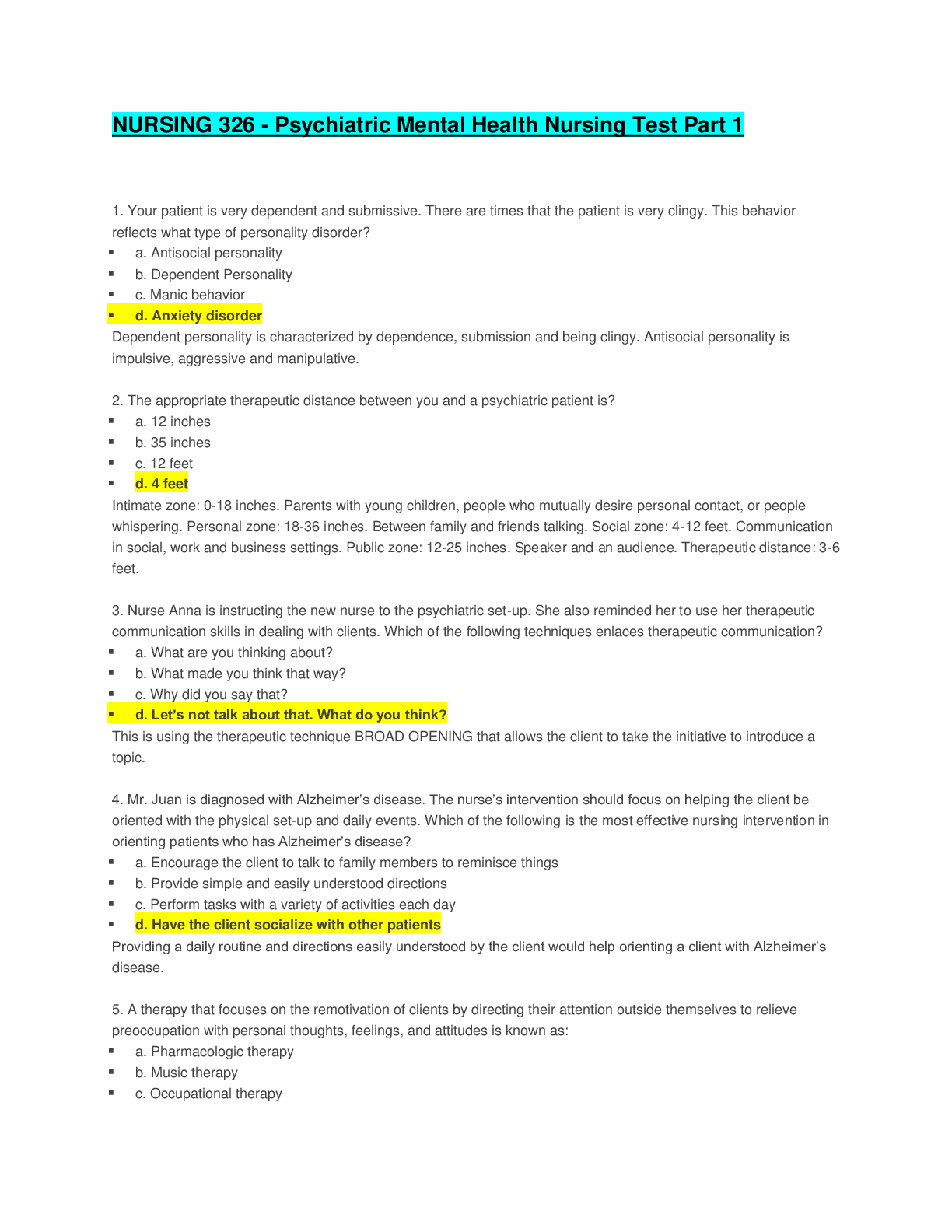
Reviews( 0 )
Document information
Connected school, study & course
About the document
Uploaded On
Mar 15, 2020
Number of pages
5
Written in
Additional information
This document has been written for:
Uploaded
Mar 15, 2020
Downloads
0
Views
228

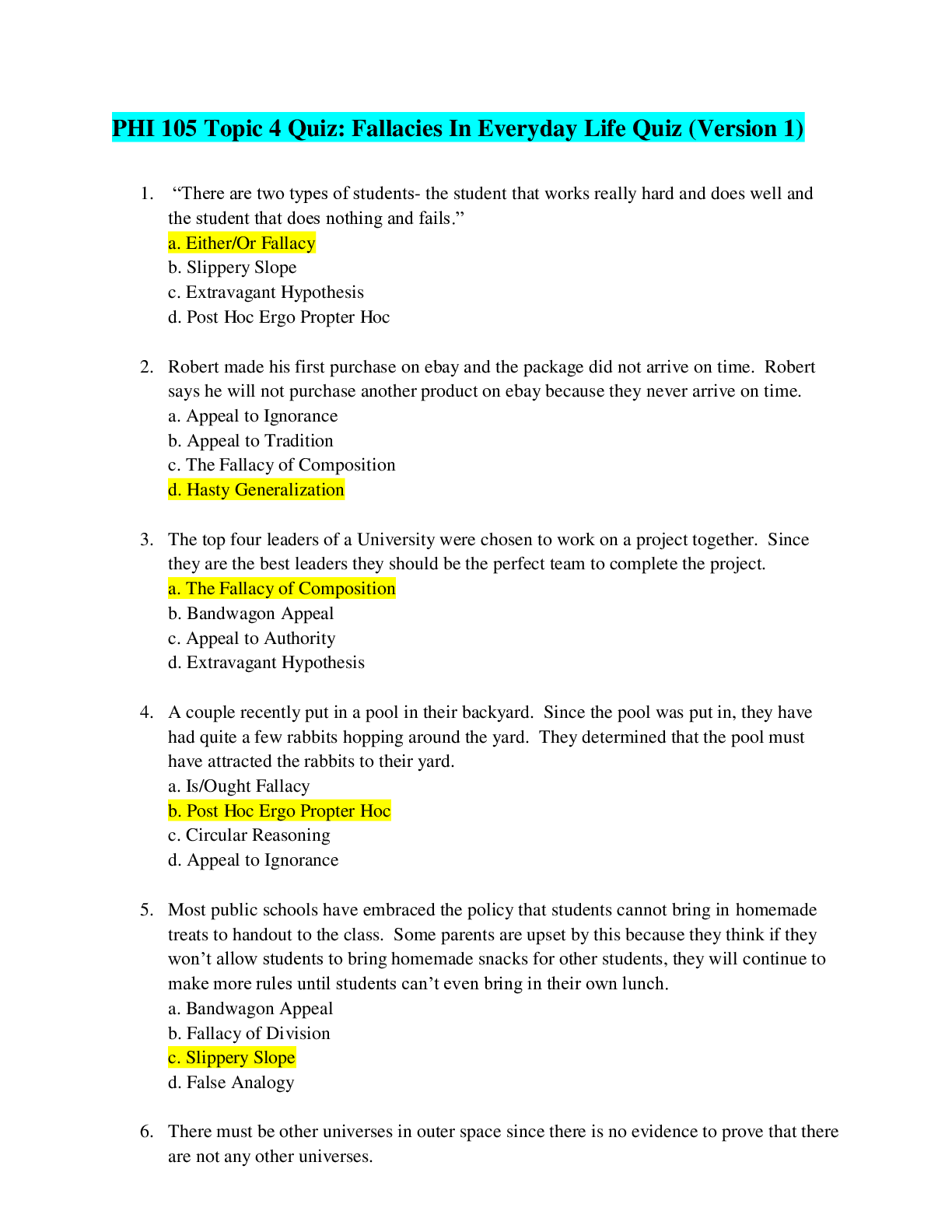


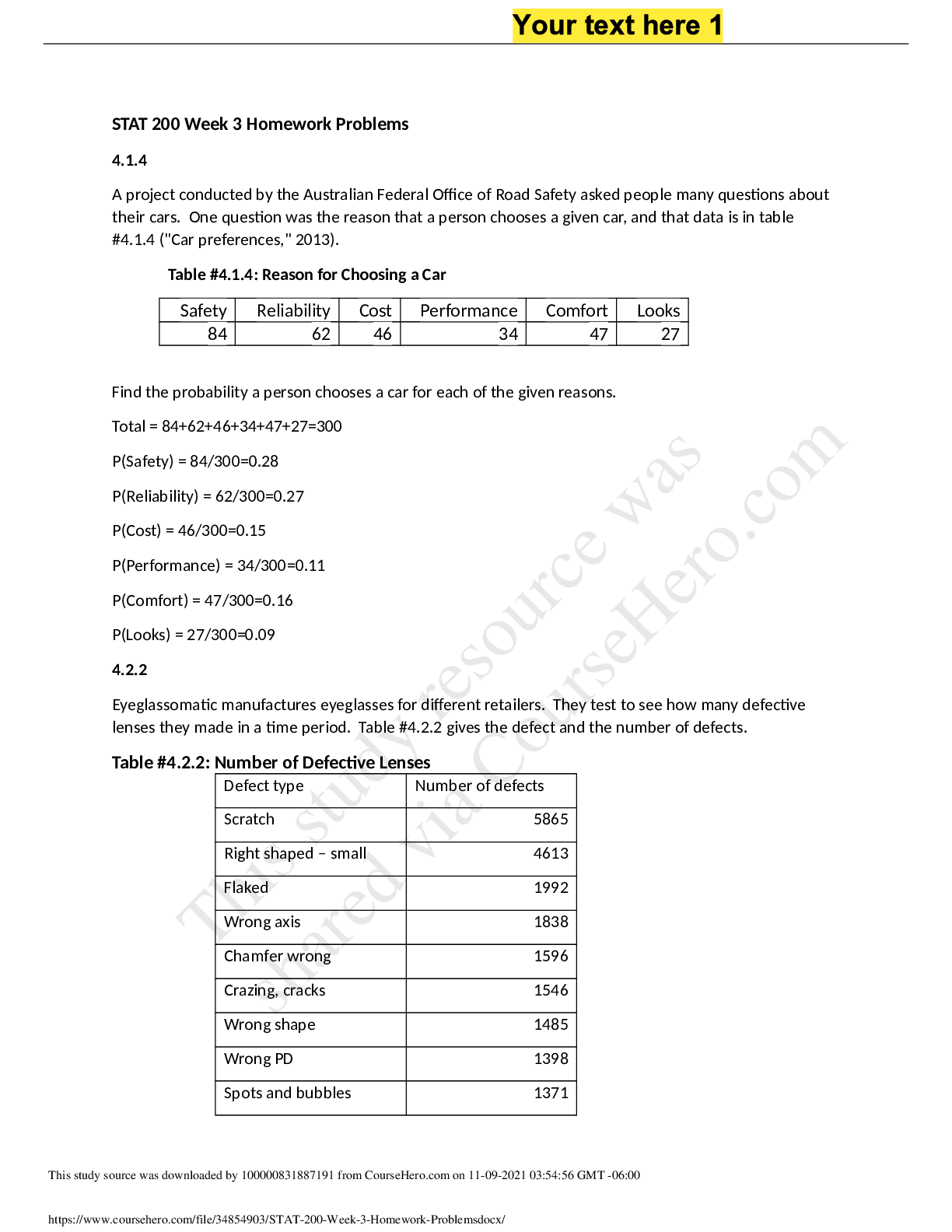
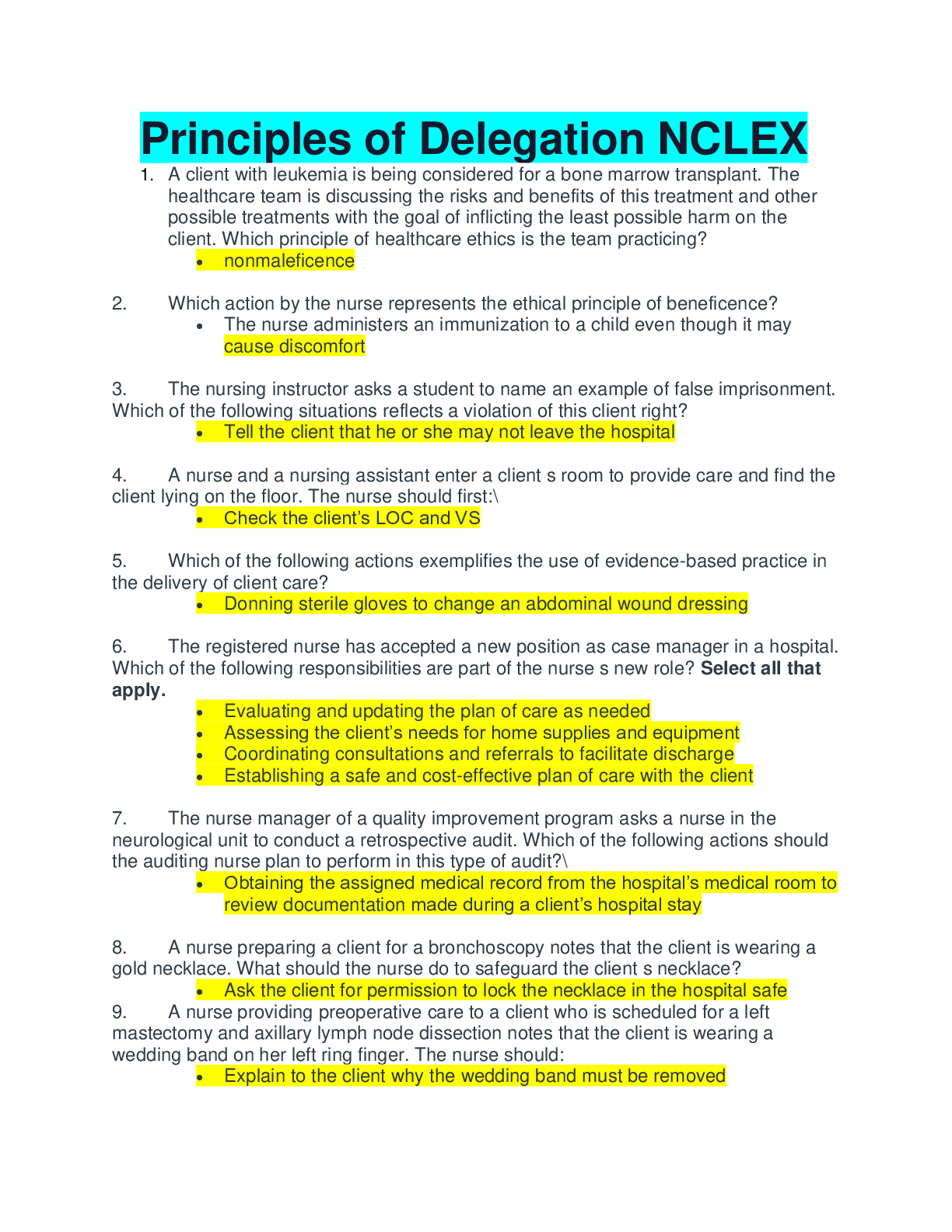
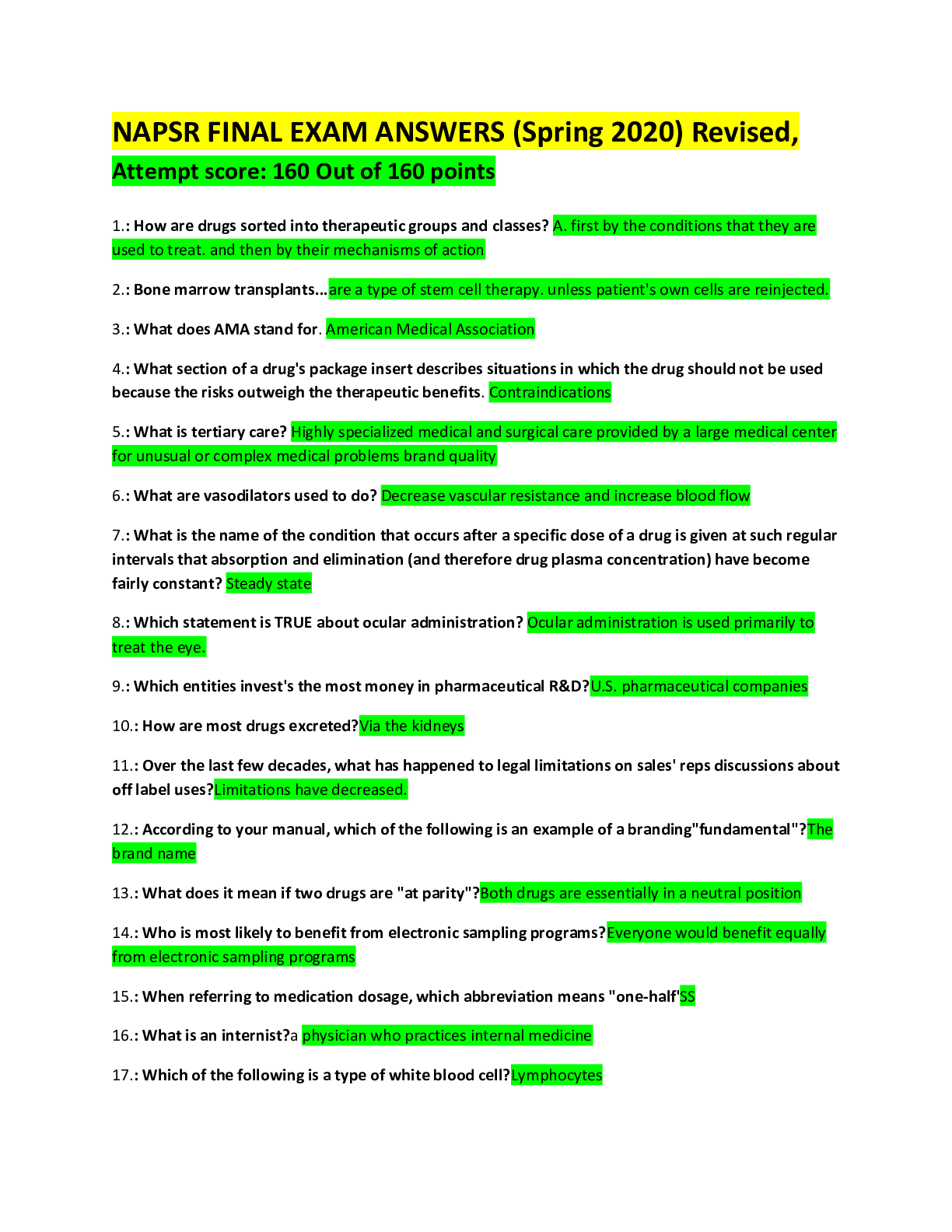
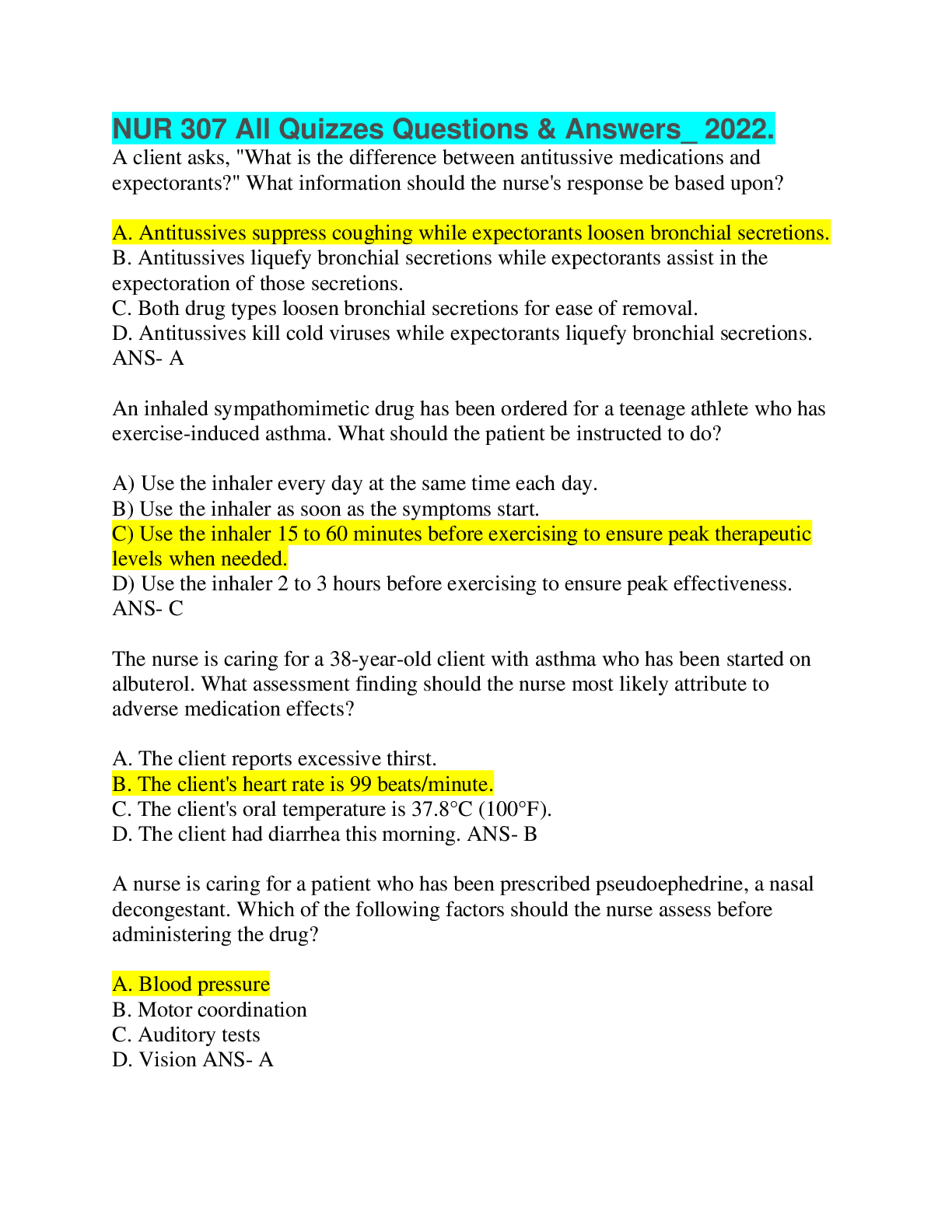
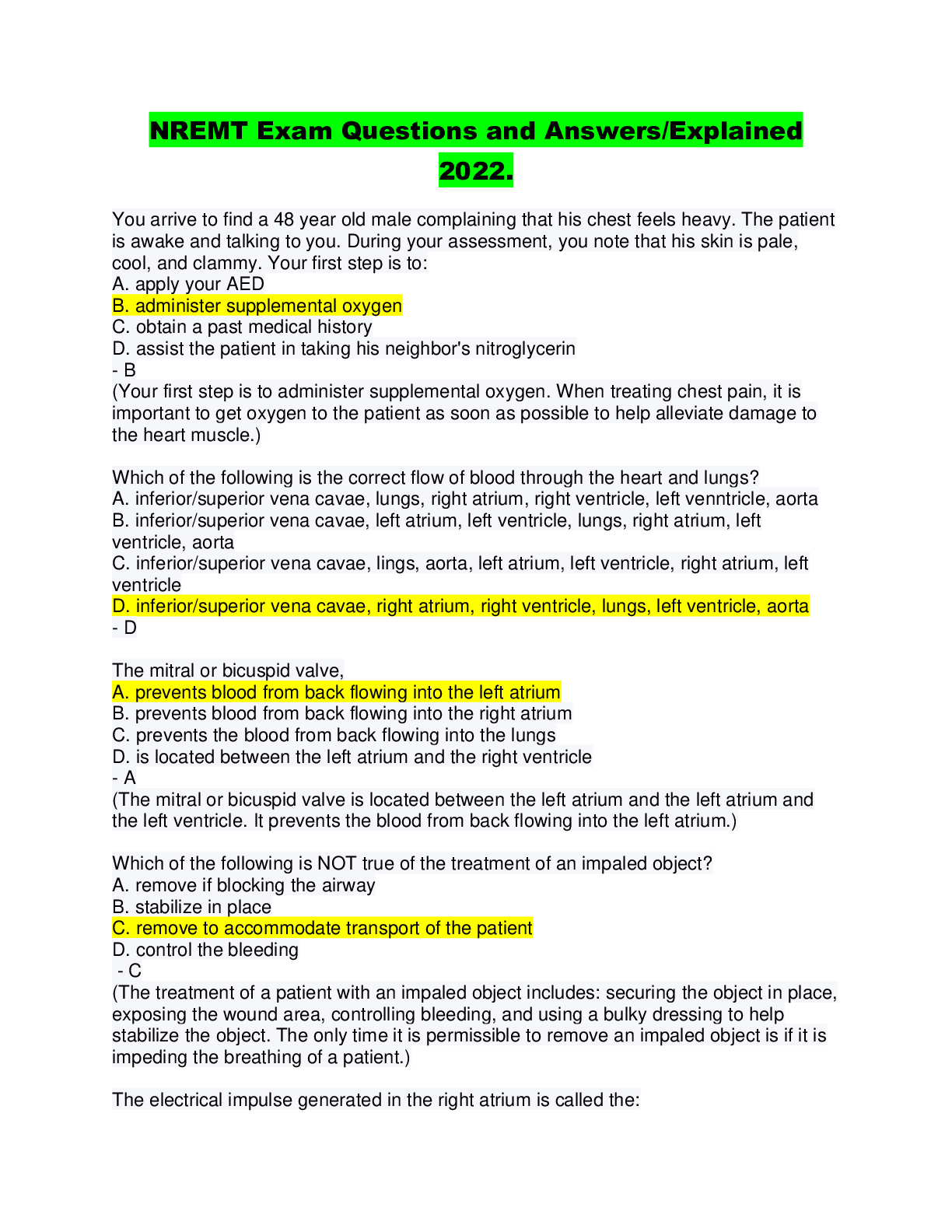

.png)
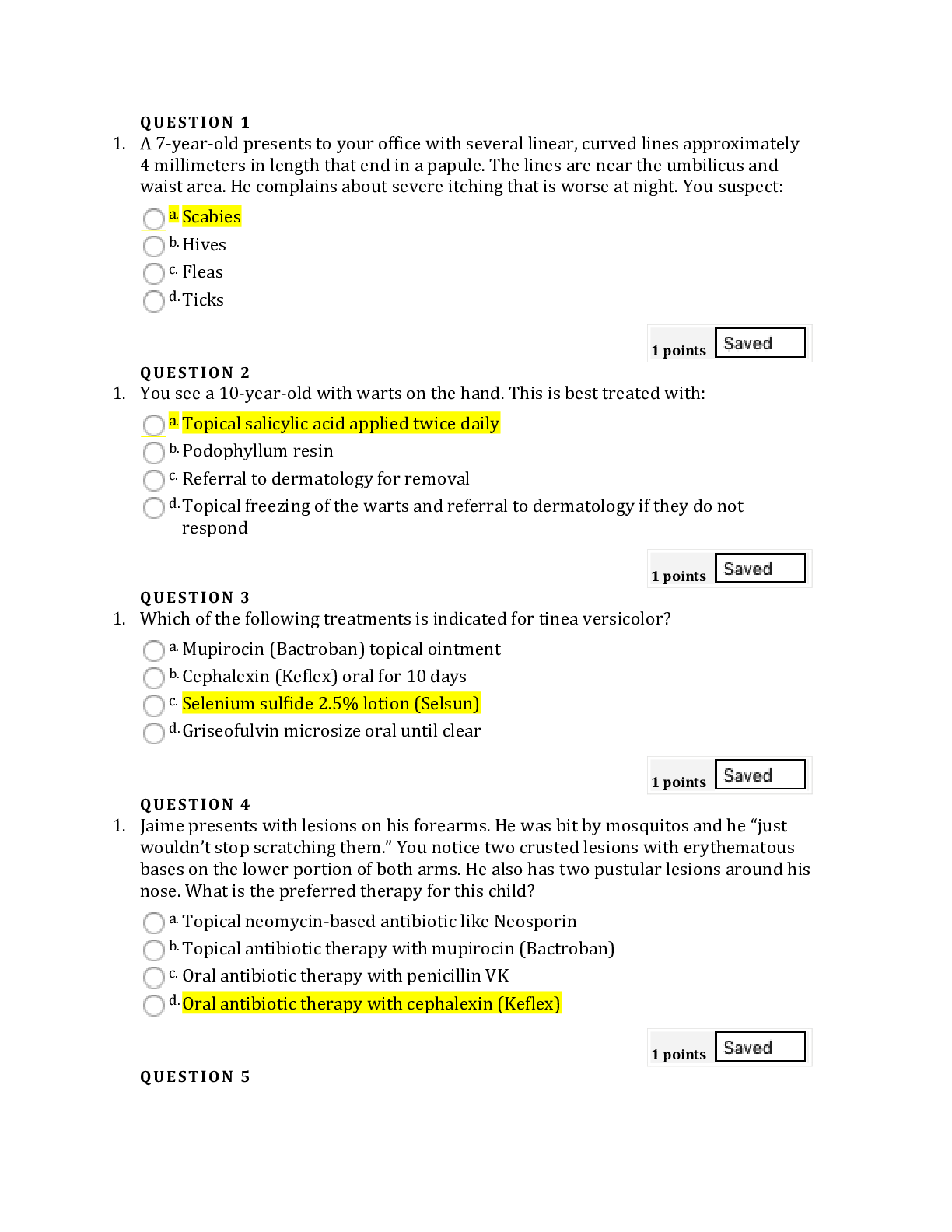
.png)
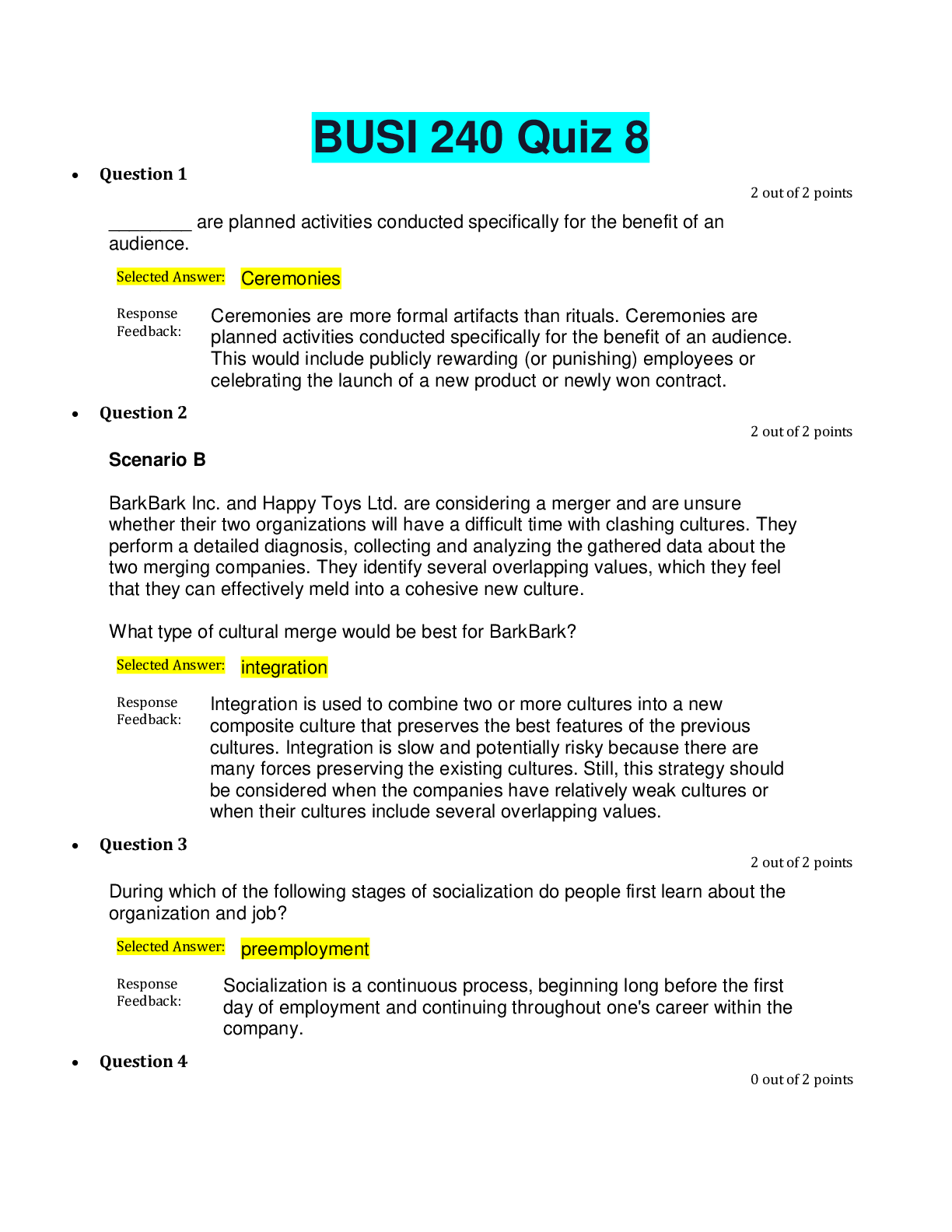
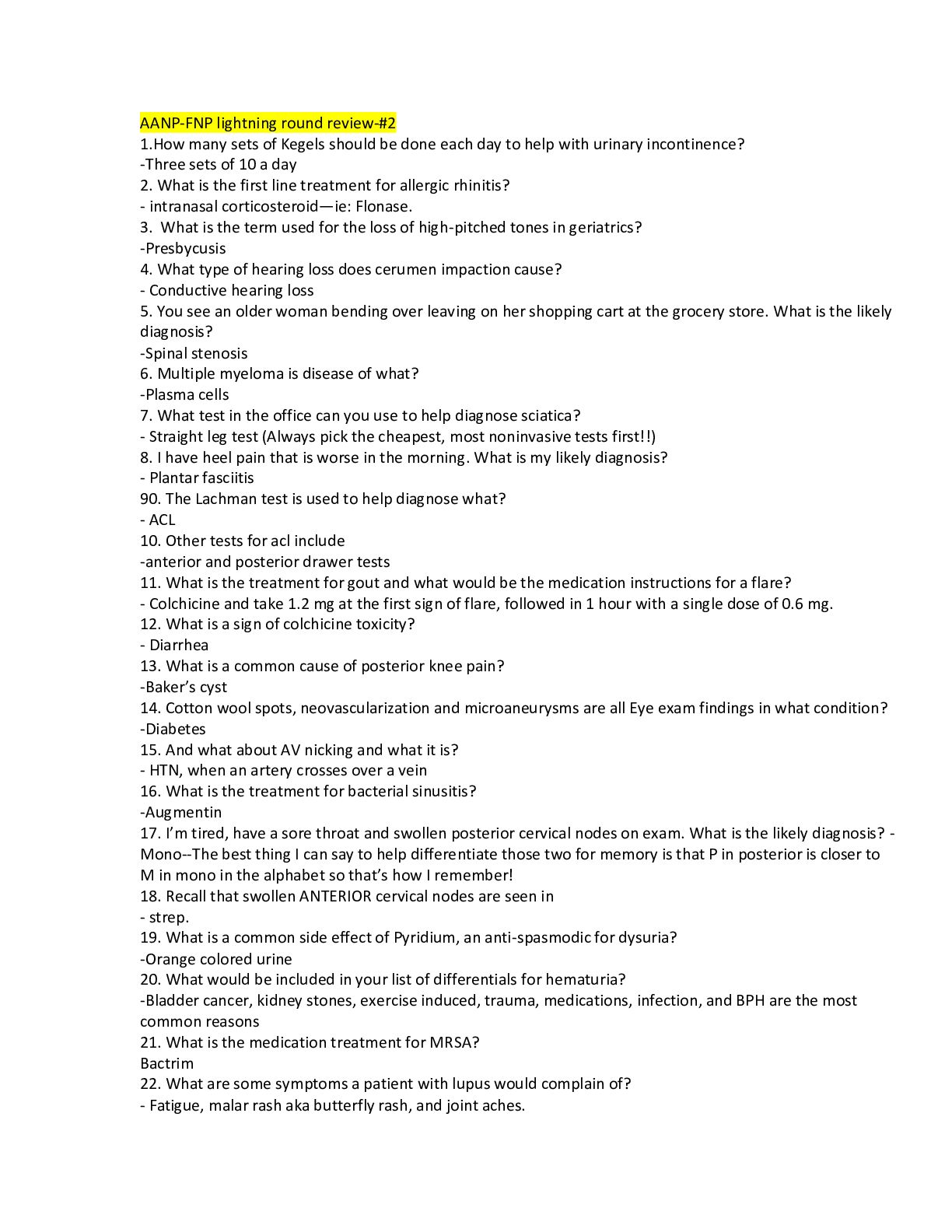
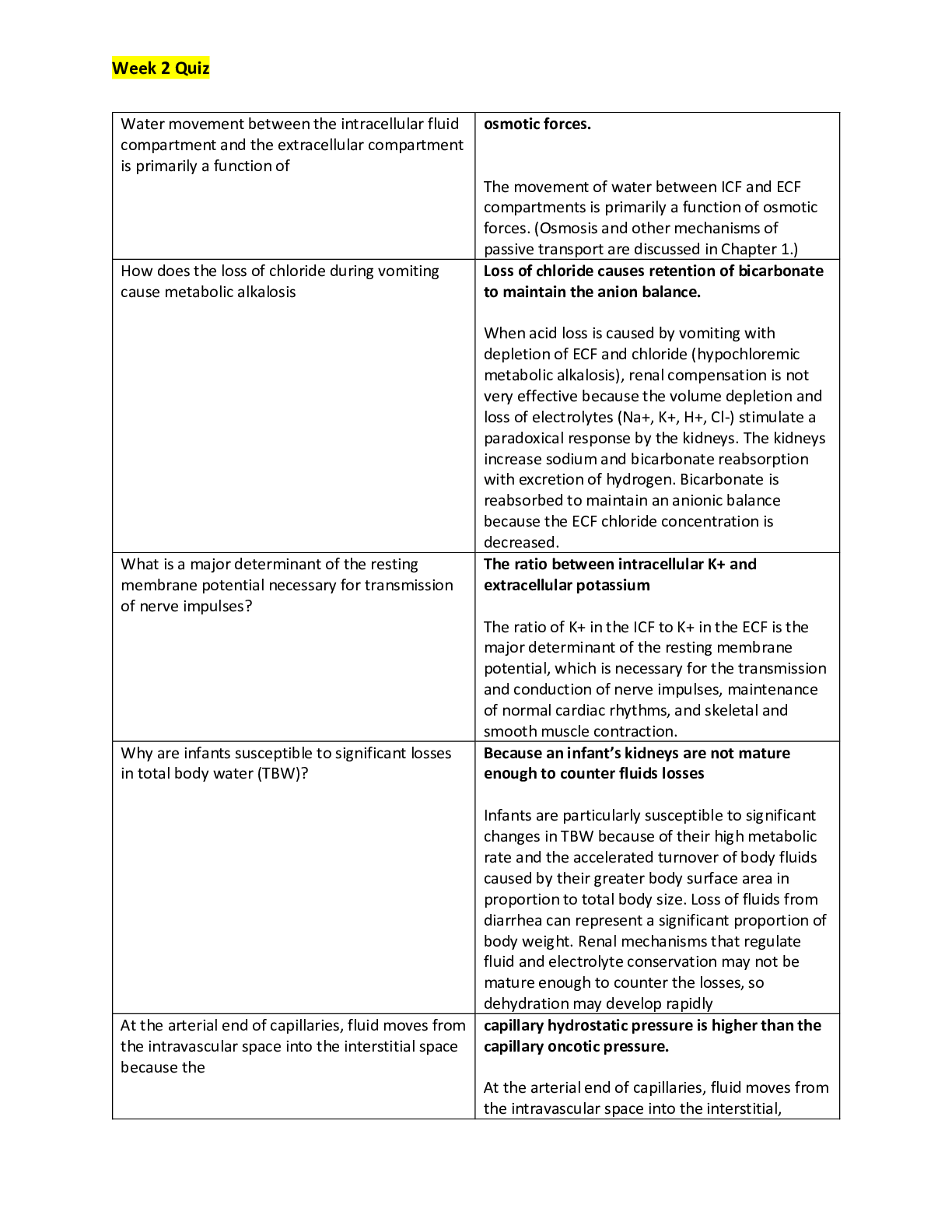
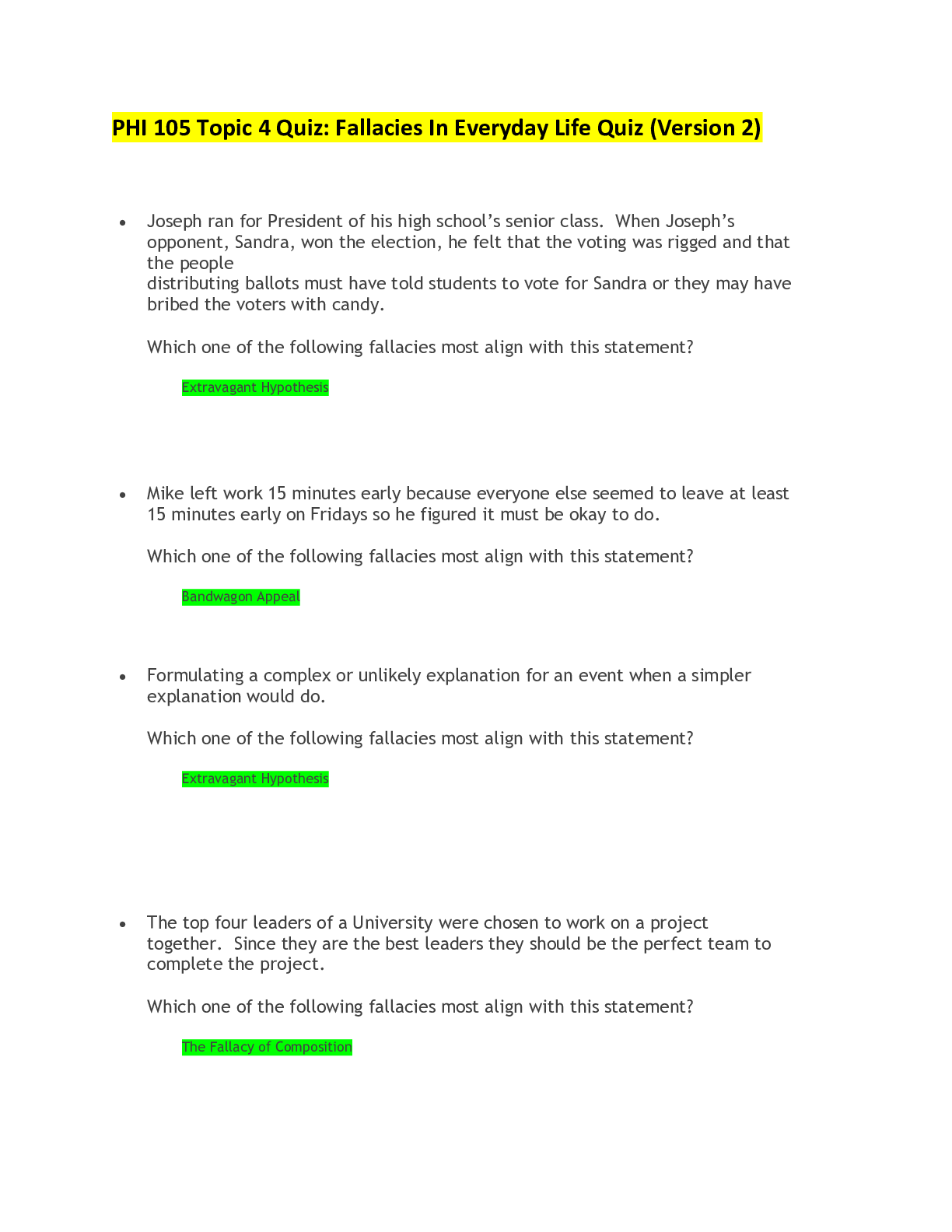
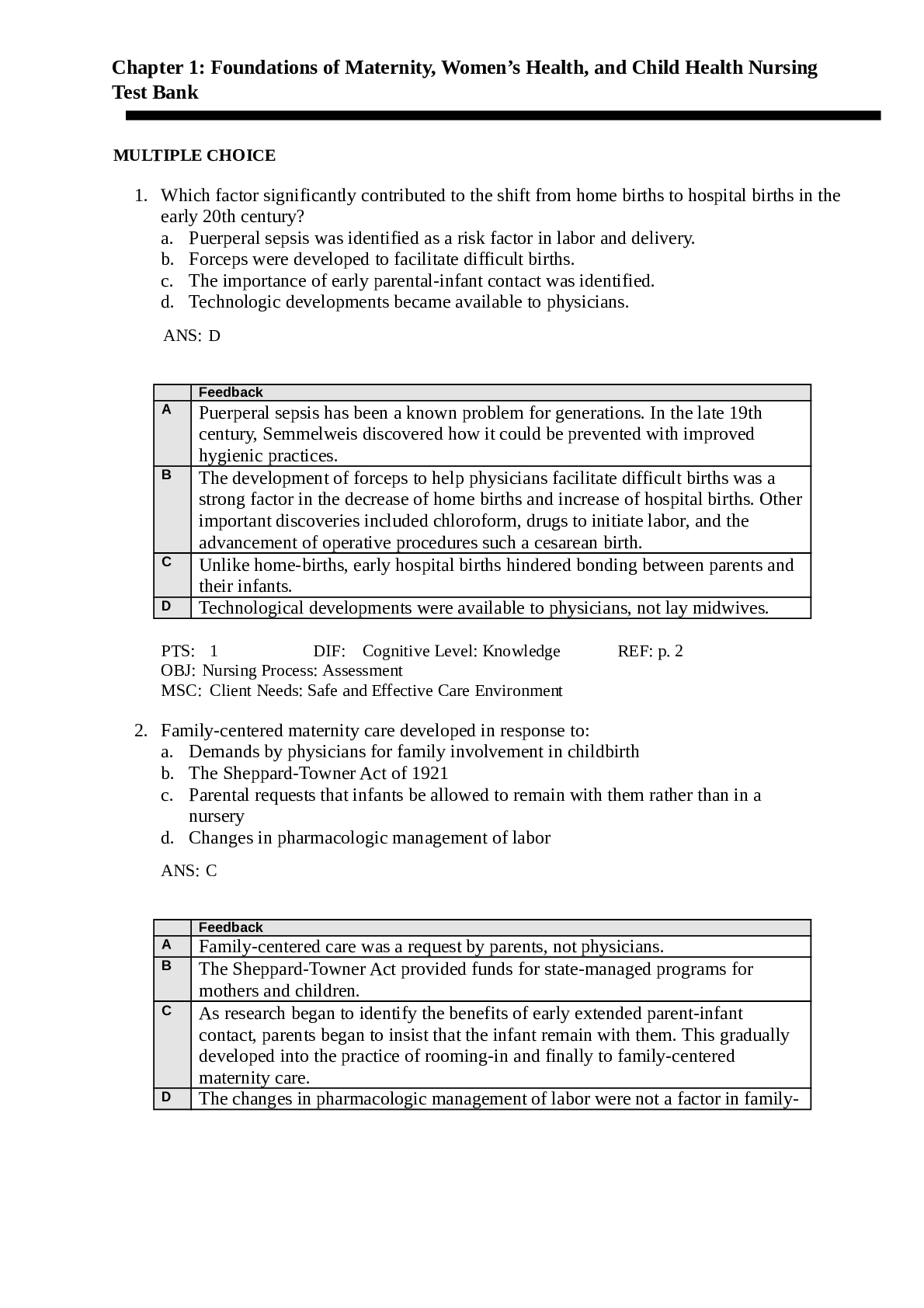
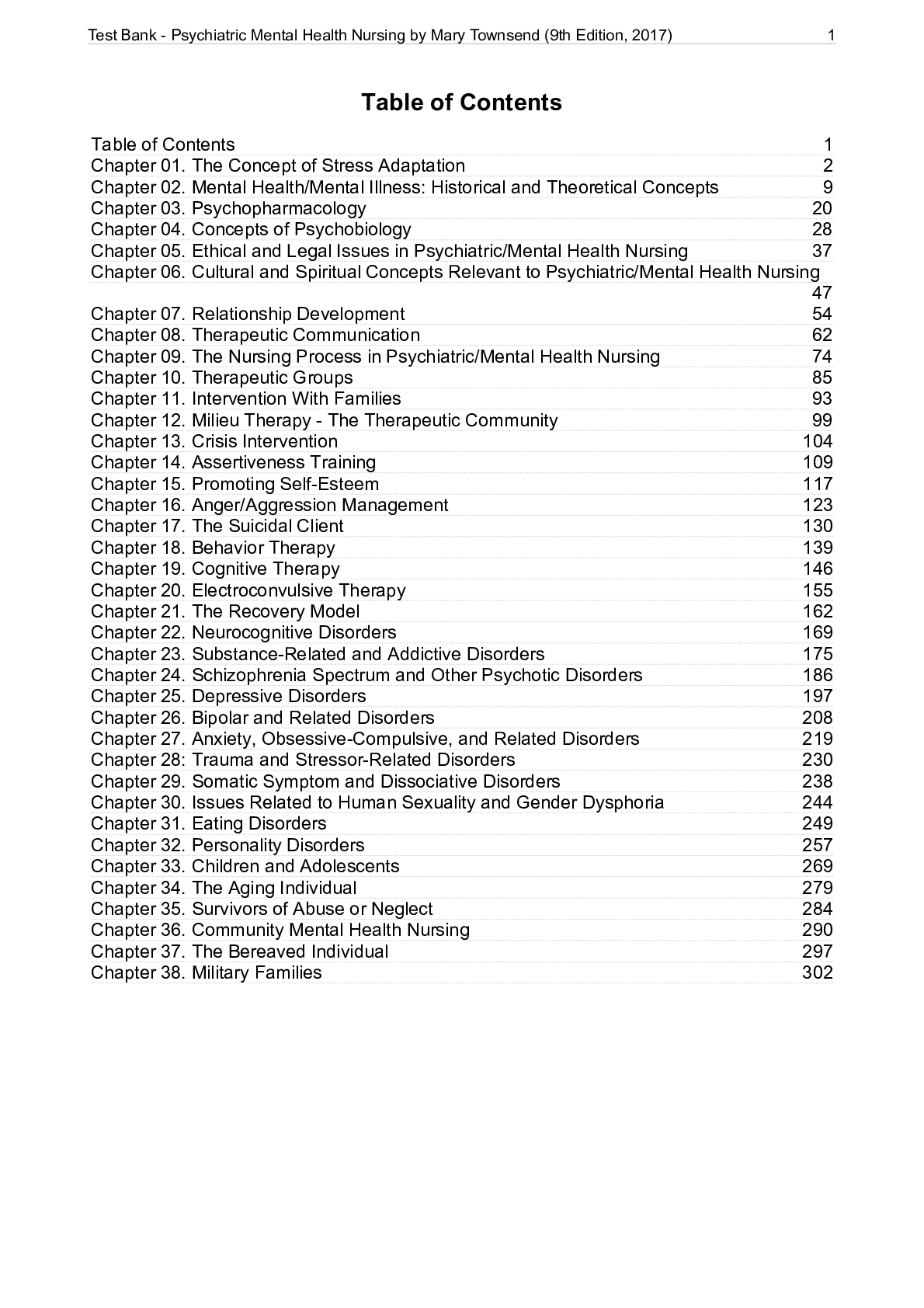
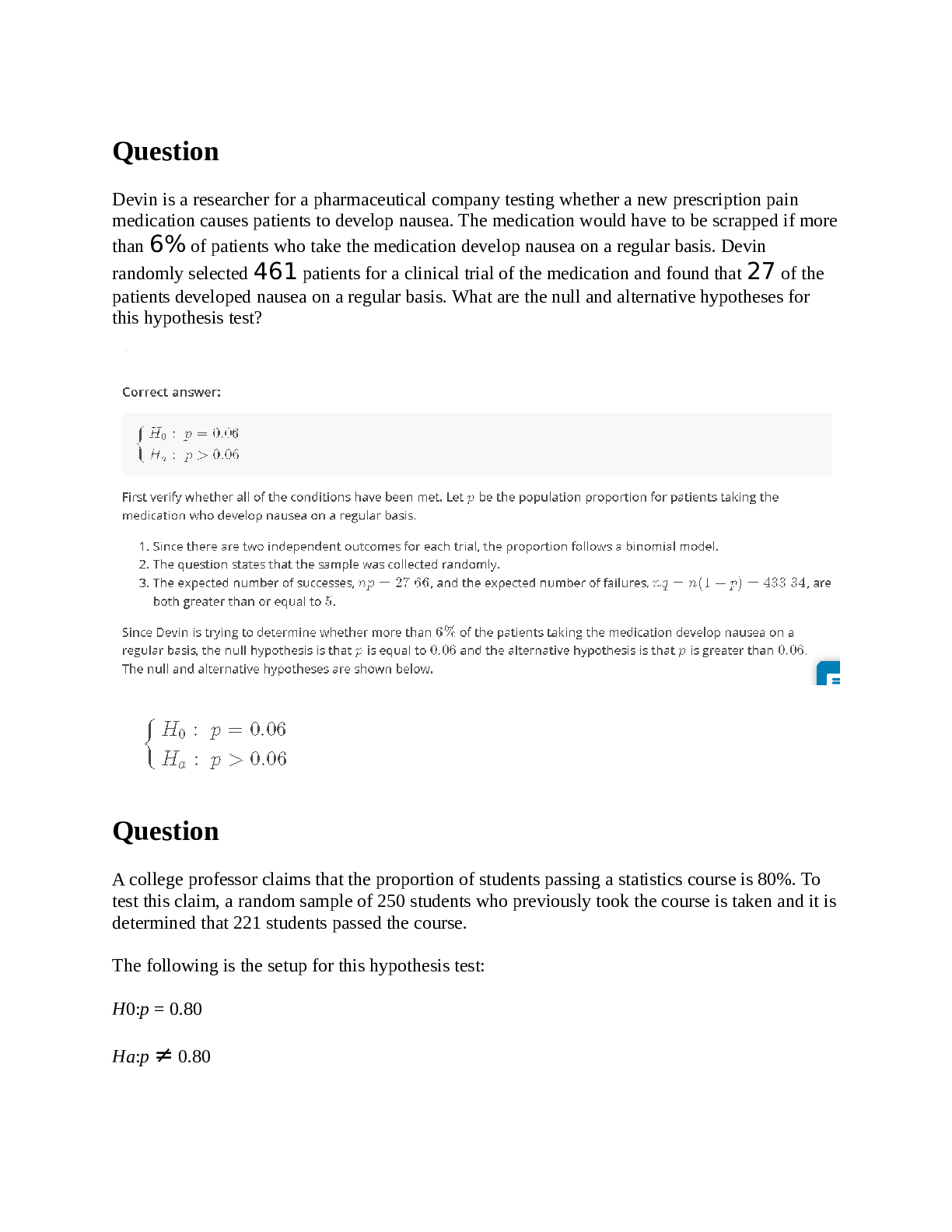
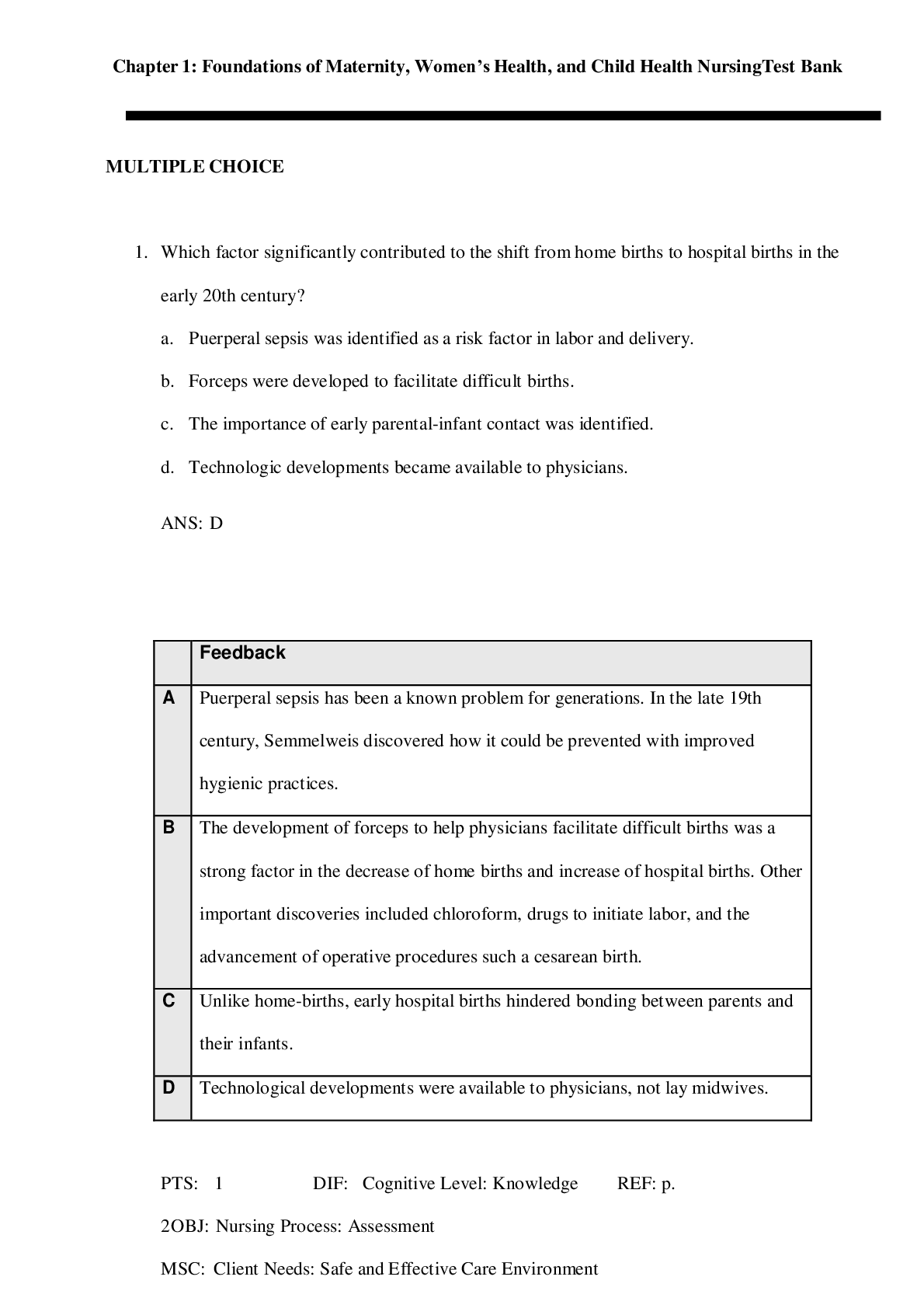
.png)

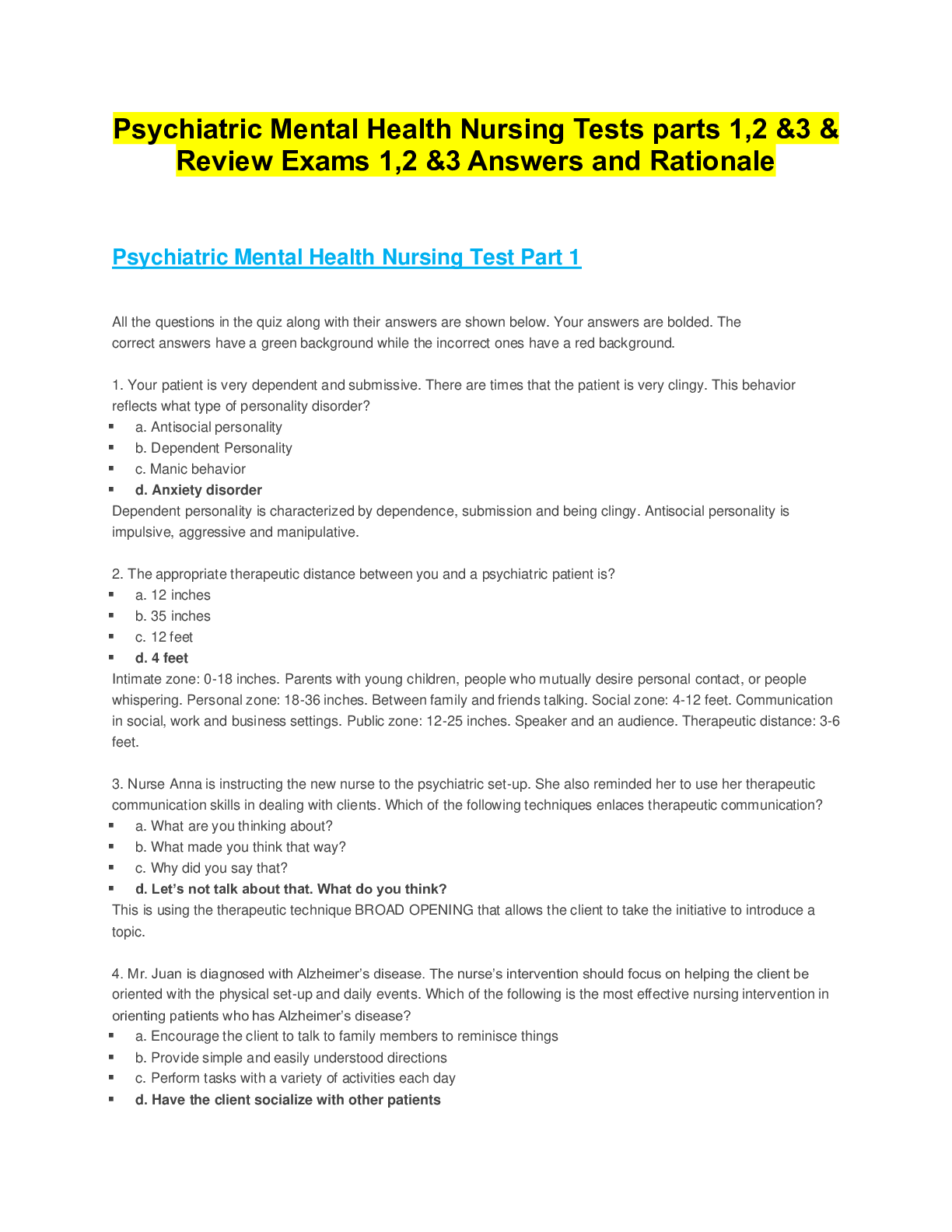
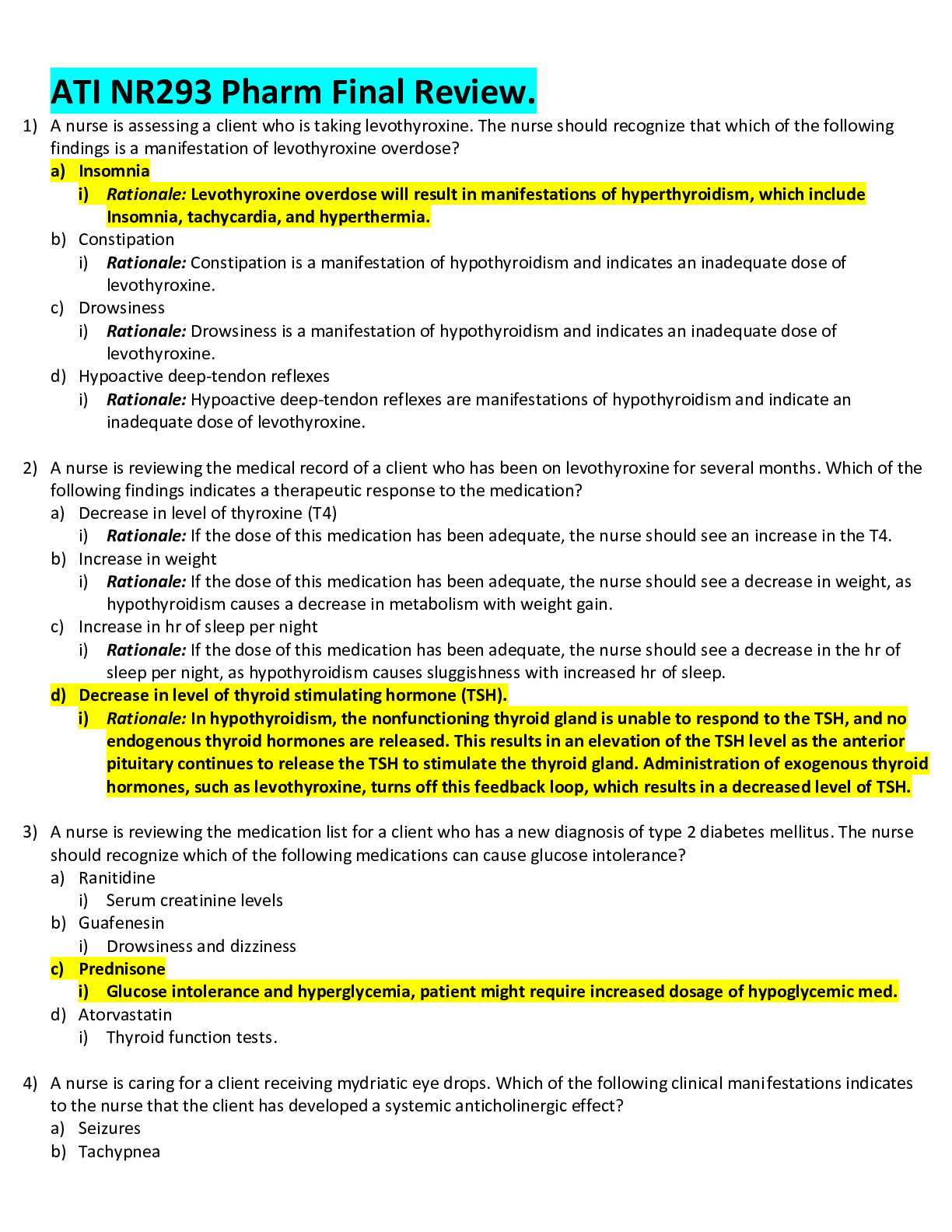
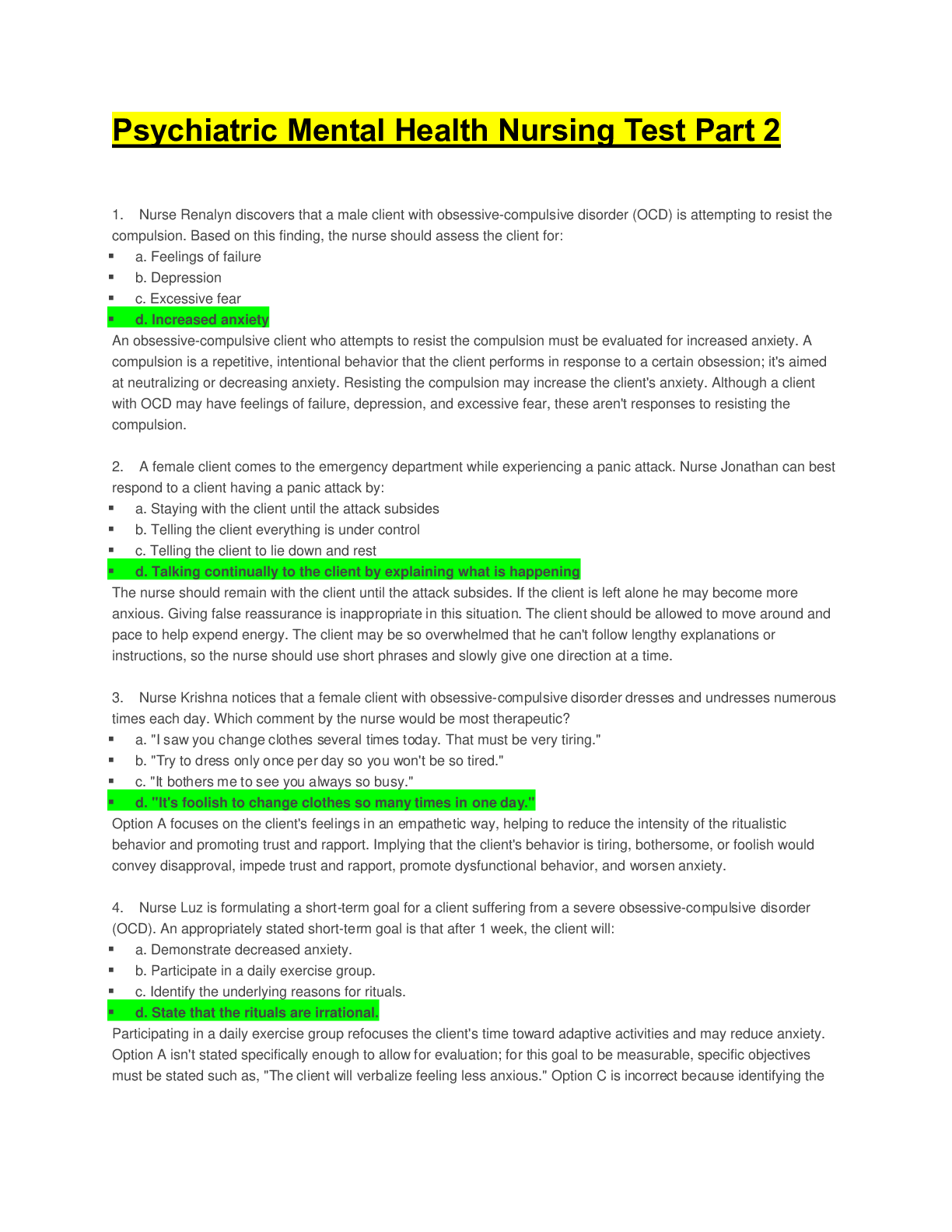
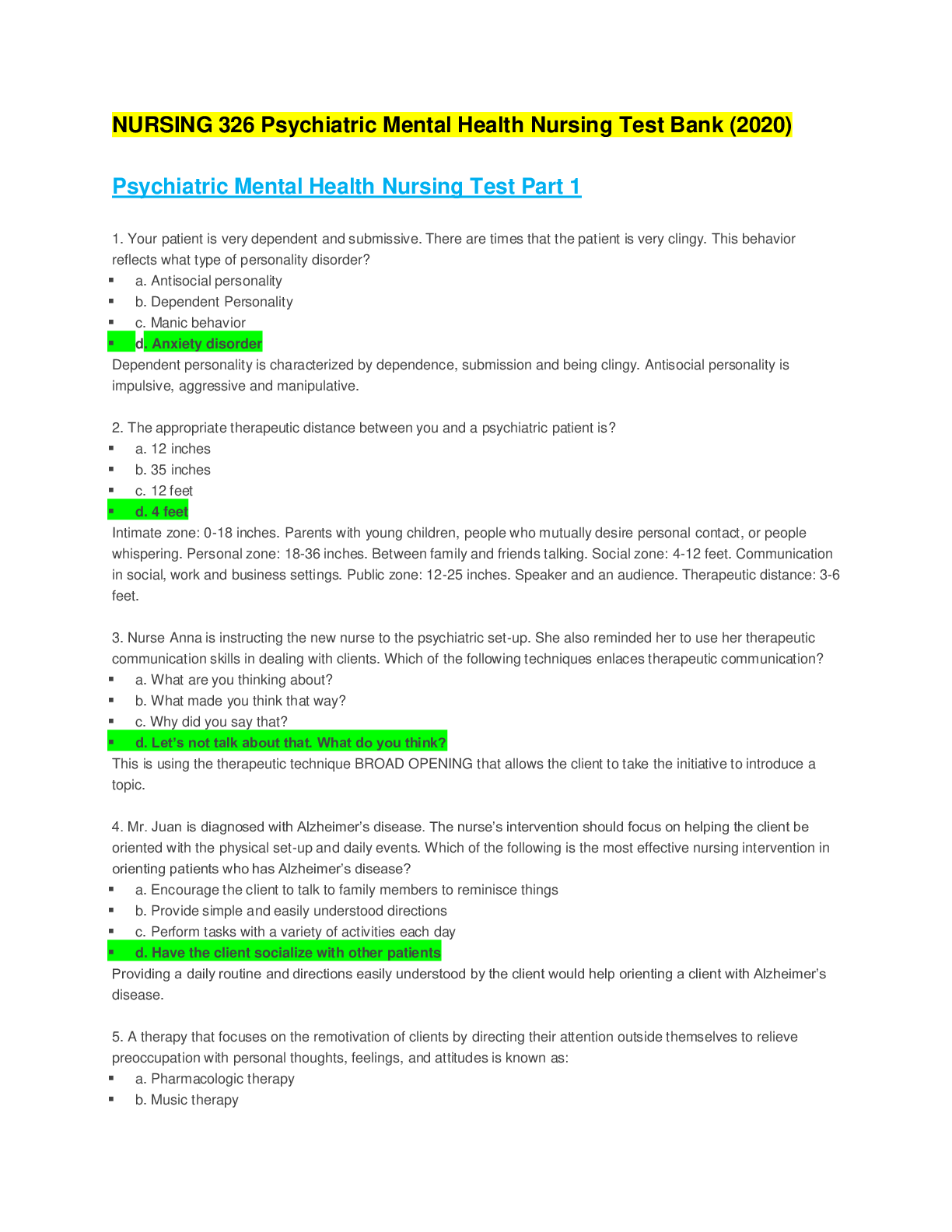
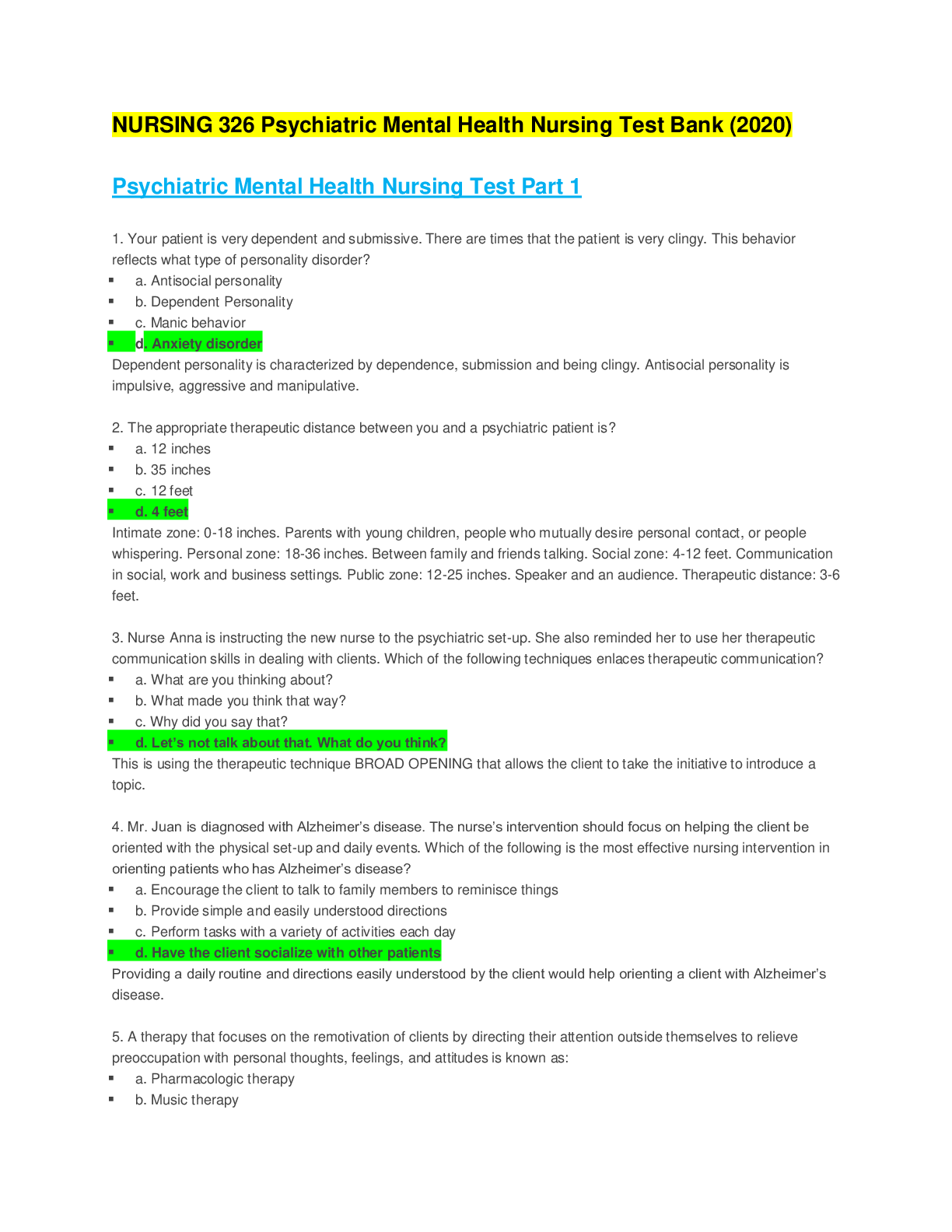
 (1).png)

